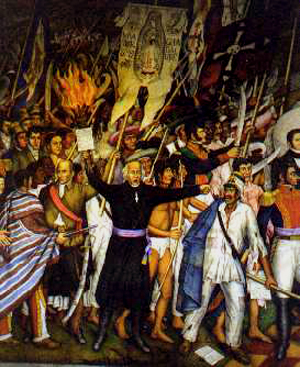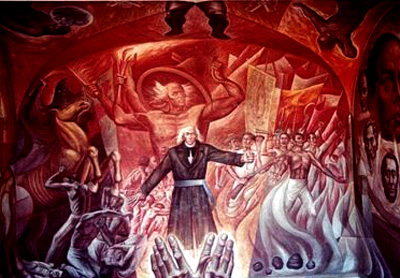 |
American History
The Cristeros – Part III
Hildalgo Raises the Standard of Revolt
Luiz S. Campos
The Cristiada and the Cristeros ... these epic names belong already to the domain of legend. I refer, of course, to the glorious Catholic counter-revolutionay uprising against the anti-clerical Mexican government in the years 1926 to 1929.
Many studies today try to explain the reason for that explosion of hatred and violence by the Mexican government against Catholics in the bosom of an apparently homogeneous nation. I believe that the revolutionary propaganda presenting the military resistance of the Cristeros against the Mexican government as a revolt of the poor against the rich, of the Indians against the colonizer, of America against Europe is contrary to the truth. The reality is different and tragic: the people were defending the traditional values and the legitimate monarchy, while the “enlightened” elites promoted the revolution and persecution.
The movement of the Cristeros came from a healthy reaction of the Catholic people who wanted to preserve the Catholic Faith and traditions of Christian Civilization.
Foreign influences over Mexico
The French Revolution had overthrown the Monarchy in France and Napoleon was toppling all the monarchies of Europe to transform them into egalitarian republics. In many cases, he actually succeeded in this. To this strong revolutionary wind blowing from Europe was added the influence over Mexico of the newborn United States of America, molded by the same “enlightened” principles.

Madrid surrenders to Napoleon in 1808 |
In 1808 the French revolutionary armies entered Spain and took the city of Madrid. As this country was being invaded, the first call for revolution was smoldering in Mexico. Several years later, Napoleon and the French troops were expelled from the Iberian Peninsula, but he left the bad fruits of the French Revolution incorporated into the liberal Spanish Constitution of 1812.
The invasion shook the old social order in Spain and opened an era of turbulence, political instability, and economic stagnation. The Spanish revolutionaries would take advantage of that situation. A devastating civil war between liberal and absolutist factions broke out and persisted in the Iberian Peninsula until 1850.
That political turmoil in the mother land would encourage revolts in the Spanish colonies of Latin America. Almost all of its colonies took up the revolutionary banner and claimed their independence.
The birth of the liberal revolution
Part of the Mexican Catholic clergy was deeply influenced by the Enlightenment. The seminary of St. Nicholas College in Vallidad was one of the centers cultivating these liberal ideas. As a consequence of that influence, the first call for independence in Mexico was made shortly before dawn on September 16, 1810 by a revolutionary and adulterous priest, Miguel Hidalgo y Costilla.
Hidalgo was a liberal priest from St. Nicholas College who championed the new “democratic” ideas and wanted to do away with monarchy in Mexico. This priest nicknamed “The Fox” lived a scandalous and sacrilegious life. Among other things, he openly opposed the absolute power of the Pope, the perpetual virginity of Our Lady and clerical celibacy. In spite of having been investigated by the Inquisition, he was given the parish of small town of Dolores, near the city of Guanajuato. From there he gave the famous “Grito de Dolores,” or Shout of Dolores. Under the hypocritical pretense of preserving the country for Ferdinand VII, the Spanish and rightful King, he proclaimed the independence of Mexico.

Holding the torch of Enlightenment and under the banner of the Virgin, Hidalgo begins his march to Mexico City |
Hidalgo was quite aware that his revolutionary ideas would not hold together the insurgency. So, to bring people to his cause the priest adopted the image of the Virgin of Guadalupe as his banner. On his troops’ standards he inscribed the words: “Long live religion! Long live our most Holy Mother of Guadalupe! Long live King Ferdinand VII! Long live America and death to bad government!”
From Dolores, encouraged by liberal intellectuals and priests, a mob of ranch hands opened the prisons to increase the numbers of partisans of the Revolution. With these unruly troops, Hidalgo started his march toward the Capital, murdering, looting and stealing along its way. Only in Guanajuato, more than 500 were killed in a wild and bloody massacre. A red terror swept through other towns and villages.
By the time the mob reached Guadalajara, Hidalgo had accumulated 100,000 men and 95 pieces of artillery. His company, however, was completely disorganized and lacking in military discipline. When he entered into battle with the royalist General Calleja - who had only 6,000 men - Hidalgo suffered a complete defeat. With his lieutenants and 1500 of his mob, he tried to reach the Rio Grande to flee to the United States. But before that he was caught in the desert. In July 1811, less than a year after his Shout of Dolores, he stood before a firing squad, and paid the price of his own blood for the blood of so many innocents that he had shed.
Nonetheless, Hidalgo’s “grito de Dolores” had planted the seeds of a Mexican revolution that would precipitate New Spain into unceasing unrest and troubles for more than a century. It would lead to the implantation of a Masonic Republic that would initiate one of the most atrocious persecutions made directly against the Holy Church. In this persecution the Cristeros would play their unforgettable role.

A mural in Guanajuato celebrates the revolutionary priest Miguel Hidalgo as the father of the Revolution in Mexico |
To be continued

Posted March 20, 2009

Related Topics of Interest
 The Cristeros I: The Spaniards Land in Mexico The Cristeros I: The Spaniards Land in Mexico
 The Cristeros II: Long Live the Virgin of Guadalupe! The Cristeros II: Long Live the Virgin of Guadalupe!
 Catholicism in Colonial America Catholicism in Colonial America
 La Conquistadora: Our Country's Oldest Madonna La Conquistadora: Our Country's Oldest Madonna
 Ven. Antonio Margil of Jesus: Apostle of New Spain and Texas Ven. Antonio Margil of Jesus: Apostle of New Spain and Texas
 The Appeal of the Stones at San Juan Capistrano The Appeal of the Stones at San Juan Capistrano

Related Works of Interest
|
|
History | Home | Books | CDs | Search | Contact Us | Donate

© 2002-
Tradition in Action, Inc. All Rights Reserved
|
 |
|